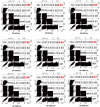This is a preprint.
RanBALL: An Ensemble Random Projection Model for Identifying Subtypes of B-Cell Acute Lymphoblastic Leukemia
- PMID: 39386448
- PMCID: PMC11463541
- DOI: 10.1101/2024.09.24.614777
RanBALL: An Ensemble Random Projection Model for Identifying Subtypes of B-Cell Acute Lymphoblastic Leukemia
Abstract
As the most common pediatric malignancy, B-cell acute lymphoblastic leukemia (B-ALL) has multiple distinct subtypes characterized by recurrent and sporadic somatic and germline genetic alterations. Identifying B-ALL subtypes can facilitate risk stratification and enable tailored therapeutic design. Existing methods for B-ALL subtyping primarily depend on immunophenotyping, cytogenetic tests and genomic profiling, which would be costly, complicated, and laborious. To overcome these challenges, we present RanBALL (an ensemble Random projection-based model for identifying B-ALL subtypes), an accurate and cost-effective model for B-ALL subtype identification. By leveraging random projection (RP) and ensemble learning, RanBALL can preserve patient-to-patient distances after dimension reduction and yield robustly accurate classification performance for B-ALL subtyping. Benchmarking results based on > 1700 B-ALL patients demonstrated that RanBALL achieved remarkable performance (accuracy: 0.93, F1-score: 0.93, and Matthews correlation coefficient: 0.93), significantly outperforming state-of-the-art methods like ALLSorts in terms of all performance metrics. In addition, RanBALL performs better than tSNE in terms of visualizing B-ALL subtype information. We believe RanBALL will facilitate the discovery of B-ALL subtype-specific marker genes and therapeutic targets to have consequential positive impacts on downstream risk stratification and tailored treatment design. To extend its applicability and impacts, a Python-based RanBALL package is available at https://github.com/wan-mlab/RanBALL.
Conflict of interest statement
Competing Interests The authors declare no conflict of interest.
Figures






References
-
- Hunger Stephen P., Mullighan Charles G. Acute Lymphoblastic Leukemia in Children. N Engl J Med. 373 (16): 1541–52. - PubMed
-
- Meyers S, Alberti-Servera L, Gielen O, Erard M, Swings T, De Bie J, et al. Monitoring of Leukemia Clones in B-cell Acute Lymphoblastic Leukemia at Diagnosis and During Treatment by Single-cell DNA Amplicon Sequencing. HemaSphere [Internet] 2022;6(4). Available from: https://journals.lww.com/hemasphere/fulltext/2022/04000/monitoring_of_le... - PMC - PubMed
-
- Bassan R, Hoelzer D. Modern Therapy of Acute Lymphoblastic Leukemia. J Clin Oncol. 2011. Feb 10;29 (5):532–43. - PubMed
Publication types
Grants and funding
LinkOut - more resources
Full Text Sources
Research Materials
